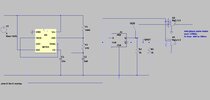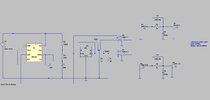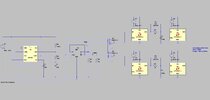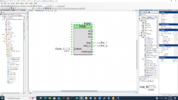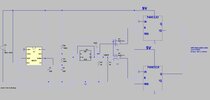Hi,
ICM7555 has a max frequency of 500kHz. (T=2us) However, pg 8 Fig 9 says there is a ~250ns propagation delay when vdd=5v.
That must mean that the duty cyle when at 500kHz must be limited to 0.75 maximum?
ICM7555
https://www.nxp.com/docs/en/data-sheet/ICM7555.pdf
Do you know what the max duty cycle can be of the output at 120kHz?
Just noticed the graph, Fig 12, on page 10 of the ICM7555 datasheet is incorrect.....it gives RA=RB=1k and C=7nF giving 200kHz....whereas the equation (1) on page 12 gives that as 65.7kHz.
___***___
Basically, we need the following attached 555 based sync’ing cct to be able to deliver pulses of <500ns width at 240kHz. So the 555 output must be 240kHz, with a duty cycle of no less than 0.91. Do you think this is possible with a ICM7555?
LTspice and jpeg attached of sync’ing cct (it syncs a UCC28070A)
ICM7555 has a max frequency of 500kHz. (T=2us) However, pg 8 Fig 9 says there is a ~250ns propagation delay when vdd=5v.
That must mean that the duty cyle when at 500kHz must be limited to 0.75 maximum?
ICM7555
https://www.nxp.com/docs/en/data-sheet/ICM7555.pdf
Do you know what the max duty cycle can be of the output at 120kHz?
Just noticed the graph, Fig 12, on page 10 of the ICM7555 datasheet is incorrect.....it gives RA=RB=1k and C=7nF giving 200kHz....whereas the equation (1) on page 12 gives that as 65.7kHz.
___***___
Basically, we need the following attached 555 based sync’ing cct to be able to deliver pulses of <500ns width at 240kHz. So the 555 output must be 240kHz, with a duty cycle of no less than 0.91. Do you think this is possible with a ICM7555?
LTspice and jpeg attached of sync’ing cct (it syncs a UCC28070A)
Attachments
Last edited:

